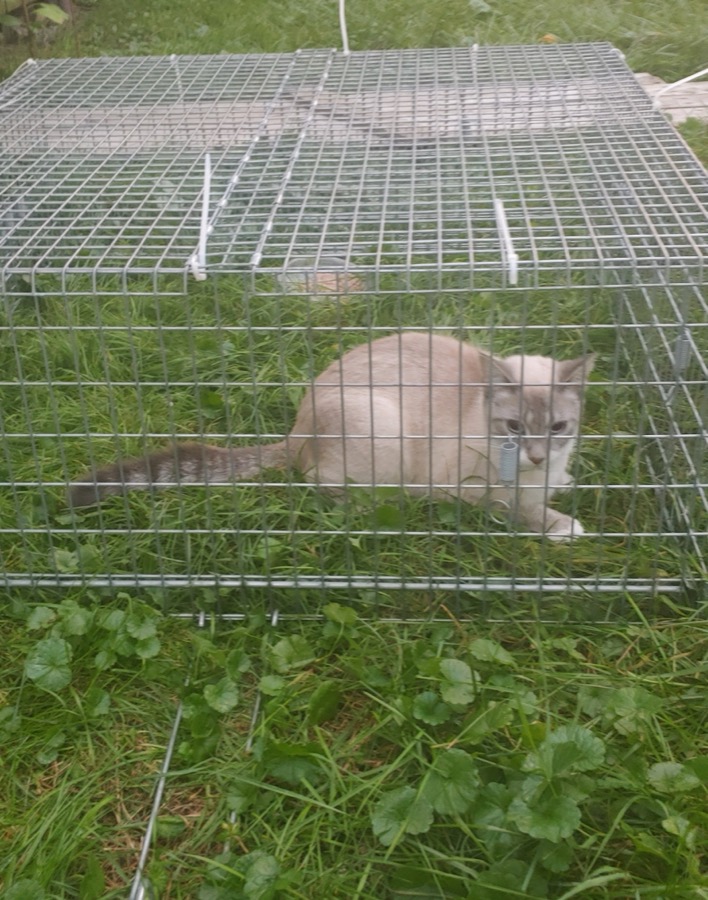Humane Trapping – Tips for Hard to Catch Cats
Cats can become trap-shy — frightened to go near or enter a trap, or trap-savvy — mastered the art of removing food without triggering the trap. Don’t be discouraged. The following are several straightforward techniques used to trap hard-to-trap-cats.
GET THE CATS USED TO EATING OUT OF THE TRAP
A short break can reduce a cat’s fear of the trap. During this time, keep feeding that cat and others in un-set traps for about a week or more before trapping again. Feed the cats in the same place and time as always. Load the trap the opposite way you normally would, so that the food is in the front of the trap and the front door is closed, because you do not want the trap set. Take off the back door or tie it securely open. Place the food by the entrance of the trap, then inside, then over a period of days gradually move it closer to the back. Feed in the same place and time as always. Monitor the traps while the cats eat to ensure traps are not stolen or a cat is not accidentally trapped. The cat will see other cats eating inside the traps and will likely try it as well. When you are ready to trap again, withhold food for 24 hours.
TRY USING A LARGER SIZE TRAP
Some cats may be more comfortable entering a larger trap that has a taller opening and wider sides.
WITHHOLD FOOD FOR UP TO TWO DAYS
For a particularly trap-savvy cat, you might consider withholding food for up to two days, but do not withhold food for any longer. Never withhold water.
MAKE TRAP MORE ENTICING – USE SMELLY TREATS AS BAIT
– Bits of jarred baby food (not containing onions)
– Catnip (smear fresh catnip on trap plate)
– Make a strong-smelling broth by boiling the pungent herb “valerian root” in water, and then douse the trap with it.
– Try other types of bait, such as “people tuna” in oil, mackerel, canned cat food, sardines, anchovies, or cooked chicken.
– Cats have an extraordinary smell. Traps often smell like humans or cleaning products. Try wiping the trap with fresh catnip or sardine oil. Always leave trap covers outdoors to lose the human scent. It also might be as simple as having someone else set your trap.
Helpful Video: HOW TO BAIT TRAP RESISTANT CATS
USE DISTRACTION TECHNIQUES TO COAX CAT ONTO THE TRIGGER PLATE
You may be able to guide some cats into a trap with a laser pointer. You can use a pointer from quite a distance away, too. Use the laser to emulate the movement of an insect, to draw the cat’s attention inside the trap.
Hang a piece of cooked chicken from a string above the trigger plate. The cat will likely need to step on the trigger to reach the chicken. Tie the chicken in the far right corner of the trap so that the cat must “reach” to get the chicken.
EXTEND THE LENGTH OF THE TRIP PLATE IN THE TRAP
Do this to outsmart a clever feline who plans to walk in, have a bite, and leave).
- Cut a piece of corrugated cardboard so that it will be 12 to18 inches long and about ½ inch narrower than the inside width of the trap.
- Use masking tape or painter’s tape to secure this cardboard rectangle to the top of the trip plate.
- Use another piece of tape to secure the base end of the cardboard loosely to the wire mesh near the trap door opening. This piece of cardboard extends the length of the metal trip plate. It is essential for catching the crafty feline who walks into the trap, and then delicately places one paw over the trip plate, contentedly eating the nice snack you have left for her. When the cardboard platform covers the trip plate, and the wire mesh at the opening of the trap, the feisty feline does not notice that there is a certain point along the path to the food whereupon she will actuate the trip plate.
PLACE THE TRAP IN A MORE SECLUDED LOCATION

Moving the trap to a quieter or more protected location can raise the cat’s comfort level enough to enter.
CAMOUFLAGE THE TRAP

Even simply covering the trap with dark cloth or a towel can do the trick. Be sure that the coverings you use do not interfere with the trap door closing. Sometimes even simpler things work, like putting the trap inside a cardboard box (with the rear door not covered) or leaning a large board against a wall and putting the trap behind it so it’s hidden.
USE A DROP TRAP

If you are still unable to trap a cat or if the cat has learned how to steal bait without springing the trap, consider using a drop trap, which does not rely on a trigger plate to close the trap door. Drop traps allow you to catch a cat without having to force him into a confined space. The drop trap falls down over a cat (when triggered by you with a rope) eliminating the need for kitty to step into a narrow opening. Using a drop trap is often a last resort, because it either requires you to build or purchase your own or find one to borrow. Using a drop trap normally requires the help of another trapper. Visit NEIGHBORHOOD CATS for instructions on how to build a drop trap or option to purchase a pre-made trap.
USE A DROP TRAP
If you are still unable to trap a cat or if the cat has learned how to steal bait without springing the trap, consider using a drop trap, which does not rely on a trigger plate to close the trap door. Drop traps allow you to catch a cat without having to force him into a confined space. The drop trap falls down over a cat (when triggered by you with a rope) eliminating the need for kitty to step into a narrow opening. Using a drop trap is often a last resort, because it either requires you to build or purchase your own or find one to borrow. Using a drop trap normally requires the help of another trapper. Visit NEIGHBORHOOD CATS for instructions on how to build a drop trap or option to purchase a pre-made trap.
SPRING THE TRAP YOURSELF (WATER BOTTLE TRICK)
The problem may be a particular cat is wily, or it could be that he’s only one you want out of a crowd of others who keep going in ahead of him. In either case, the solution is to bypass the trigger/trip plate mechanism of the trap and go to manually spring the trap. You can do this by propping the trap door up with a full water or soda bottle and tying a pull string to it. Tie a long string around the neck of the bottle then stand some distance away. When your cat of choice finally goes in, yank the string, pulling the bottle away and shutting the trap door. Be sure to first practice the method at least once so you get the right feel for it, and wait until the cat is far enough in (up to or past the trip plate) before you pull the string.
Watch these short videos demonstrating how the water bottle trick works:
www.youtube.com/WATER BOTTLE TRICK
www.youtube.com/WATER BOTTLE TRICK IN ACTION
USE A FEMALE IN HEAT TO ATTRACT THE MALES
If you have already trapped a female cat in heat use her to help get the reluctant male(s). Set the traps end to end as in trapping mom cats and kittens and cover the “bait” trap.
LURE INTO A CONFINED SPACE
If you can, lure the cat into an indoor space (with no exit, holes in the wall, etc.) and close the door behind him. Once confined, you can take the patient route by setting a normal trap and otherwise depriving of food (though this can take days).
If you can’t or don’t want to wait, then before you lure the cat in, take out of the space everything the cat could hide behind or under. Leave only a single large board (approx 5 ft. long, 3 ft. wide) leaning against one wall, creating a triangular space. Place a set trap on the floor at one end of the board and block off the open space right above the trap with a sheet. When the cat enters the room and is frightened, he’ll run behind the board, sometimes straight into the trap. If he doesn’t go right in, gently poke a broomstick into the non-trap opening of the board to encourage him to move forward. If it doesn’t work, withdraw, let the cat calm down, then try again later.
TAKE A BREAK FROM TRAPPING
If a cat will not go into a trap after repeated attempts, take a break for a week or two (except in the case of an injured cat). The trap-shy cat needs to be reconditioned to not be afraid to go in the trap. It is important to stop trapping until you have trapped the trap-shy cat. Continuing will most likely result in the cat becoming increasingly reluctant.
